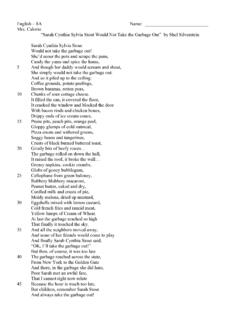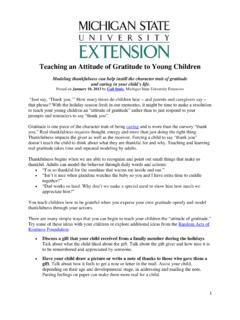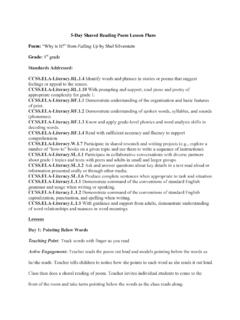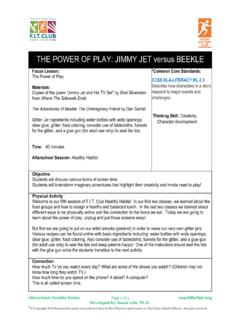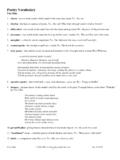Transcription of Poetry Unit - 2 - Homestead
1 2nd grade Poetry unit 2nd grade Poetry unit 2nd grade Poetry unit 2nd grade Poetry unit Week 1: Gettting Started Read Poetry Aloud: Read favorite poems aloud to your class. Begin to notice what poets do, but don t dissect the poems. Enjoy them! Reader s Workshop: During this time, students should be immersed in Poetry and reading a variety of Poetry (independently or with a partner). Students share their favorite poems and discuss or notice what they like or dislike. Optional Ideas to Use Throughout the unit : Institute Poet of the Day: Institute Poet of the Day. Encourage students to sign up a day or two in advance to read a favorite poem aloud to the class. Introduce Poetry to the class. Read aloud favorite poems to the class. Invite students to read Poetry during Reader s Workshop, either independently or with a partner.
2 Share and enjoy favorite poems. Poetry Corner: Designate an area just for Poetry , all year long. Provide lots of free-verse Poetry including poems related to science and nature, and whatever subjects your kids are interested in. Poetry Notebooks: Try having kids keep a special notebook or section of their writing notebook just for Poetry . In this space they can write their own peotry and copy their favorite poems by other authors. Having their own work and favorite poems close by makes it easy to go back to memorable wording and encourages kids to reread poems. You may find students memorizing and reciting their favorites, and they can illustrate them too. MPS 2007 Week 2: Beginning to teach Poetry Writing Lessons 1-3: What Do We Already Know About Poetry ? 6+1 Trait connection: Ideas Discuss and chart ideas from the question: What Do We Already Know About Poetry ? Write students responses on chart paper.
3 Put a student poem on an overhead transparancy and notice and discuss the poem as a whole. (See attached poems from Regie Routman). Show students both the handwritten and published drafts. Students may begin to notice the title, topic, word choice, line breaks, white space, imagery, rhythm, expression of feelings, ending line, repetition, layout of poem, and more. Use any of the following poems to notice and discuss: I Like Hockey Violin Nervous Piano Recitals Bees I m the Pilot Reading Hummingbirds A Windy Day River After the first session, brainstorm topic ideas together for which students can write. Add to the chart of topics and post in the classroom. Lessons 4-5: Writing the First Poems 6+1 Trait connection: Ideas, Word Choice, Voice Oral Brainstorming (5-15 minutes): Review topic list of ideas for writing Poetry . As a whole class, have one-to-one conversations with a few students, asking them to discuss what they might like to write a poem about.
4 At this time, all students should be gathered together with everyone listening in. These conversations will encourage students to pursue a topic he/she is interested in and to think about word choice, voice, beginnings, endings, and so on. Beginning to Write (20-25 minutes): After a few similar conversations about topic and word choice, the students should begin to write Poetry . Write about what really matters to you. Read your poem over to yourself to see if it sounds right. Speak the words aloud softly to yourself so you can really hear how it sounds. Think about how you want your poem to look on the page as you write it. If you finish one poem, start another. Afterwards, those of you who want to share a poem may do so. Have fun writing! (Routman) Sharing (5-15 minutes): Allow those students who are eager to share their favorite poems do so. For follow-up Poetry -writing sessions after the first one have kids do some oral brainstorming before sending them off to write.
5 Week 3: Writing Minilessons Lesson 1: Choosing Language Carefully 6+1 Trait connection: Word Choice, Voice Minilesson (5 15 minutes): Put transparencies of students poems on the overhead. Use the poems to spark observation and discussion about the images, moods, and depths of each poem. Possible poems to use: Hummingbirds Rollerblading Butterflies Independent Writing (20-25 minutes) Sharing (5 15 minutes) Lesson 2: Ending Lines 6+1 Trait connection: Organization, Presentation Minilesson (5 15 minutes): Put transparencies of students poems on the overhead. Use the poems to spark observation and discussion about ending lines. Curly Fries capitalizes many words for special emphasis and how ending line brings closure. I m the Pilot uses ending line to surprise the reader and let us know what the poem is really about. River ending line asks a question and sparks curiousity.
6 A Windy Day ending line shows personification, changes the pattern of language, brings sophisticated closure. All My Friends poem doesn t sound complete without ending line. The last line connects to earlier lines but that s not all and but I still have more. Independent Writing (20-25 minutes) Sharing (5 15 minutes) Lesson 3: Repetition 6+1 Trait connection: Sentence Fluency, Word Choice Minilesson (5 15 minutes): Put transparencies of students poems on the overhead. Use the poems to spark observation and discussion about repetition. Summertime how repeating the lines Don t get me wet! three times gives the poem a comfortable rhythm and also reminds us that all moms are like this! Hummingbirds repetition of Hummingbirds and see which creates a beautiful structure. Storm repetition of Oh four times as well as her repeated use of different sounds of thunder and rain give this poem a stormy rhythm.
7 Birds how the poet begins and ends the poem in a similar way, which gives the poem a graceful pattern and rhythm. Independent Writing (20-25 minutes) Sharing (5 15 minutes) Lessons 4-5: Line Breaks and White Space 6+1 Trait connection: Organization, Presentation Minilesson (5 15 minutes): Put transparency of the student s poem Peas on the overhead (first draft without line breaks). teach them how to think about and apply line breaks. Have students listen to the rhythm to determine the best place to put a line break. Read the poem several times. Put line breaks where necessary. Introduce the term stanza which means a unit within a larger poem. As you look through the poems together, notice the different ways students arranged their poems on the page to create the white space. Additonal poems to use: My Cousin Alexis Student writen poem (with permission) Independent Writing (20-25 minutes) Sharing (5 15 minutes) Week 4: Different Types of Poetry Lesson 1: Writing a List Poem 6+1 Trait connection: Ideas, Word Choice Minilesson (5 15 minutes): The Paper Bag Game Put five classroom objects in a brown paper bag (marker, ball, paintbrush, Lego, and paper clip, etc).
8 Then ask one student to stick a hand in the bag and, without telling the other students what it is, describe it to them. The rest of the class has to guess what the object is based on its description. The describer can tell the class how the object feels or what it is used for. As the child describes the object, record the descriptions in list form on a piece of chart paper. Once the class guesses the object, use the name of the object as the title of the list, which is now a list poem. (Weisbart) Here s an example: Pen Smooth Metal Fat and thin Round For writing Black Ink Independent Writing (20-25 minutes) Students write their own list poem. With remaining time, students may choose to work on a list or freeverse poems. Sharing (5 15 minutes) Lesson 2: Writing an Acrostic Poem 6+1 Trait connection: Ideas, Word Choice, Presentation Minilesson (5 15 minutes): Introduce acrostic Poetry to the students.
9 Acrostic Poetry begins with a word you choose. This word is your topic word. You should use the letters in the topic word to make other words or phrases that tell about your topic. The topic word is written down the left side of the paper. Words that describe your topic word are written across the paper. Acrostic do not have to rhyme. There are no rules for how long a word should be or how many words you should use. ( ) Show examples of acrostic poems on the overhead. Discuss and notice what we like or dislike. Using the topic list created in Week 1, choose a topic word and write an acrostic poem together. See sample poem at end of unit . Independent Writing (20-25 minutes) Students write their own acrostic poem. With remaining time, students may choose to work on acrostic, list, or freeverse poems. Sharing (5 15 minutes) Lesson 3: Writing a Shape Poem 6+1 Trait connection: Ideas, Presentation, Organization Some poems are laid out to look like the subject of the poem.
10 The result may be a solid block of print that takes a particular shape, or lines that snake around, creating a picture. (Fountas and Pinnell) Minilesson (5 15 minutes): Introduce shape Poetry to the students. Show examples of shape poems on the overhead. Discuss and notice what we like or dislike. Using the topic list created in Week 1, choose a topic and write a shape poem together. Possible resources: Doodle Dandies by J. Patrick Lewis Poke in the I by Paul Janeczko Independent Writing (20-25 minutes) Students write their own shape poem. With remaining time, students may choose to work on a shape, list, or freeverse poems. Sharing (5 15 minutes) Lesson 4-5: Continuation Minilesson (5 15 minutes): During lessons 4 & 5 other types of Poetry may be introduced to the class at teacher s discretion. Options may include the following types of Poetry : *Limerick *Lyric Poetry *Cinquain *Concrete Poetry *Haiku * Found poems *Biopoems *Narrative poems *Formulaic poems *See insert (Fountas and Pinnell: Figure 24-3) for other possible Poetry mini lessons.


